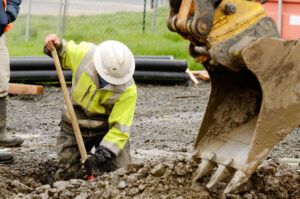
After a long winter season of limited construction, this is the time when cranes and heavy equipment start popping up like new spring flowers. The spring season is also known for bringing frequent rainfall and the possibility of thunderstorms and lightning. On busy construction sites, the unique dangers that spring weather poses to the safety of workers and site visitors cannot be underestimated. It is one of the most dangerous times of the year for construction workers, from an increased likelihood of slips and falls to the risks posed by bad weather.
Here are a few safety tips to keep construction workers safe and protected this upcoming spring season!
Wear Proper Gear
Spring rains often lead to an increase in fog, especially in the mornings, and can make visibility difficult. Personal protective equipment (PPE) should be provided to all employees, especially during low-visibility situations. When working on roadways or near traffic, construction workers should always be equipped with bright, reflective outerwear. The reflective material allows motorists to see and better identify workers when driving through a construction zone during rainy or foggy conditions.
If you can’t pause the job for bad weather, waterproof gear, protective coats, and hoods can help keep your crew working through the rain without discomfort. If workers wear a hood because it’s raining, remind them to turn their heads when they need peripheral vision. Anti-fog spray for safety glasses can help keep their field of vision clear as well.
Watch Out for Mud
Muddy boots or gloves prevent workers from getting a good grip on equipment such as ladders or machinery, resulting in a slip or fall. In an active construction zone, these types of accidents often result in far greater injury than those in other work environments. Be sure to keep extra pairs of work gloves available for employees who need them. An area where employees can clean muddy or wet work boots should be accessible throughout the day, and workers should wipe mud from their boots before mounting equipment. If the steps or rungs are muddy, they should wipe them down too. Everyone should slow it down in muddy conditions, even if it means getting less work done.
Storm Safety
The spring season is notorious for pop-up showers, unexpected strong winds, and serious storms. It’s important to be prepared for when spring thunderstorms and showers strike. Construction crews are susceptible to danger when working on or near tall, conductive materials like cranes or steel building frames in these weather conditions.
Review your protocol for lightning to ensure you understand what to do if bad weather suddenly hits. Per OSHA requirements, your team should immediately move to a safe place if they hear thunder, even if it is distant.
Fall Protection
When working at heights, safeguard yourself with fall protection PPE. Bosses should demonstrate how to properly fit a body harness and do a partner check since some harness parts are not visible to the wearer. Make sure to go over safe anchor points for personal fall arrest systems.
Anyone working 10 feet or higher above a lower level on a scaffold must generally be protected from falls by a personal fall arrest system or guard rails. Workers using single-point and two-point adjustable suspended scaffolding must use both.
Check Trenches
OSHA requires that trenches be inspected daily by a competent person before worker entry as weather conditions change. Melting snow, flooding, and spring rains could certainly alter the conditions. Workers should not enter a trench until it has been inspected.
At Ritter Forest Products, we recognize how important it is to keep workers safe during the unpredictable spring weather. That is why we rent and sell oak wooden access mats, three-ply laminated access mats, and several other timber support options. Our products assist workers on the job to create a safer and more efficient environment.
Browse our website or give us a call today to find out what equipment you need to keep your construction site safe this spring!


